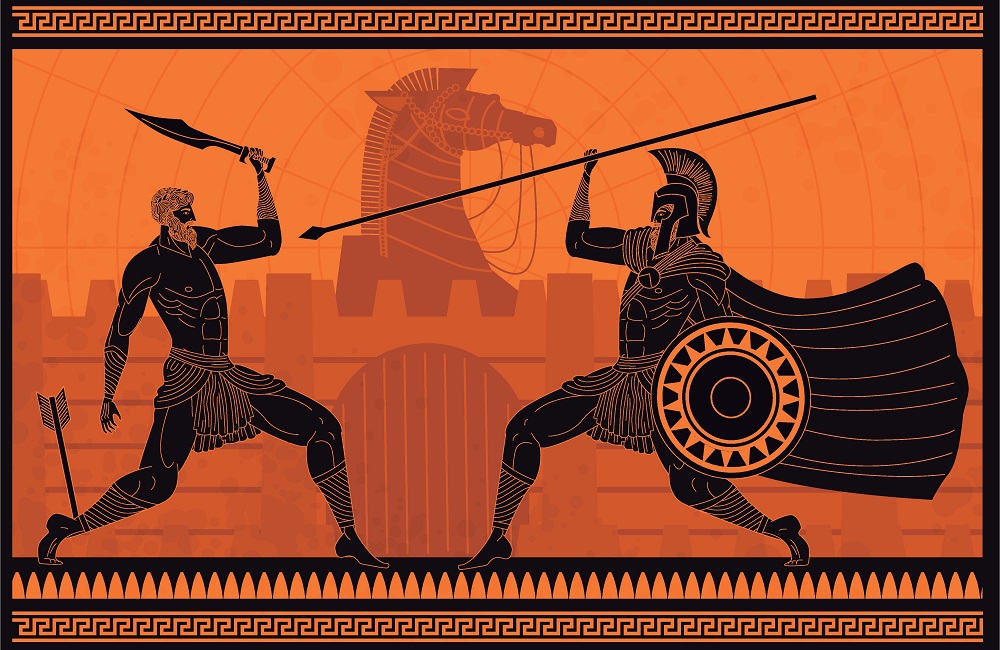Written by Fleur O’Reilly
Homer’s epic may seem rooted in Ancient Greece, a product of its time with its archaic references to hunting and a societal structure that pre-dates feudalism by millenniums. And yet, this poem is studied year after year and is one of the top-selling books. In September of this year, Emily Wilson published a new translation of the Iliad, bringing a new understanding to the story, as the first woman to have a published translation. New translations emerge every few years; Western society remains invested in understanding this ancient epic and its world.
One reason that readership continues is that the world of the epic is not actually that far removed. Despite the thousands of years that have passed between the epic’s composition and the reader, the images and descriptions are all ones that we can recognise. Similes of bees swarming, or fire glinting still resonate, and I fear for the day that these images are no longer recognizable. One such simile that always stands out for me is that of the pain of Agamemnon, where it is compared to giving birth; “Just as a sharp spasm seizes women giving birth, a piercing labour pain sent by the Eilithyiae, Hera’s daughters, who control keen pangs of childbirth, that’s how sharp pain sapped Agamemnon’s fighting strength.” This image speaks to a modern audience as much as it would have to the audience of the Romantic poets or Homer himself. They are familiar to the readership and make the text more accessible, it is not just full of old archaic language and farming images which take a whole second book to comprehend. The backdrop of the epic is the Trojan War, a battle on a scale never seen before and yet all audiences can picture a scene of war perfectly and can follow along with the scenes of family. There are a similar number of scenes depicting family and everyday life to those of battle, equally if not more familiar to the modern audience. How can one not empathise with Priam, a father pleading to Achilles for his son’s body back or Hector taking off his helmet to avoid scaring his baby? The images and story of the Iliad are not unfamiliar to a modern audience, even if the setting is.
The epic also tackles issues that are still relevant to this day. The questions of fate, inevitability, and the meaning of life are all questions we still attempt to grapple with, especially as our lives are overturned by the quickly changing world of modern technology. These questions presented by the Iliad presents resonate with modern living; after all, who hasn’t contemplated the meaning of their existence at least once?
The Iliad allows us to find out more about ourselves by asking what we would do in Achilles’ footsteps, choose a long yet unfulfilled life or a short life full of fame and glory. It asks us how much we value a legacy, a question that has tormented so many.
Therefore, reading the Iliad allows a modern audience to understand the society we inhabit. The epic has shaped the Western society we exist in, having been a fundamental part of the education of statesmen since the 1500s, with the first translation written by George Chapman in 1598. A quintessential part of the education of the upper class for the past few centuries was the classical world. The Aeneid, which can only be considered an imitation of the Iliad and Odyssey, was hailed on par with the Bible and equally admired in the education and knowledge of any upper-class gentlemen, who shaped Britain over the past few centuries. A recent former prime minister was a graduate of Classics, part of an extensive list, with Classics proving to be the most popular degree for prime ministers. The Iliad has formed how statesmen view empire and legacy. It is the book that formed the British Empire. All this and the role of Homer in modern literature has yet to be even touched upon. As the first book to be written in the western world, it is impossible to understate its influence on the literary cannon and would require a whole separate article on that alone.
Finally, it is objectively a good story. At the end of the day, people would not read something if the plot wasn’t interesting and the writing captivating. The Iliad manages to captivate audience after audience due to its story with over 1000 characters, gods and mortals, love and war, on (what can only be considered) an epic scale. Homer’s Iliad has it all in terms of plot, even if certain bits drag, such as the catalogue of ships in book 2, this is made up for by the other sections. This is an epic that remains relevant to the modern-day reader and is important in order to understand the society we occupy, with its overarching influence in literature, politics, and philosophy.
Bibliography
DEN BOER, PIM. “Homer in Modern Europe.” European review (Chichester, England)15, no. 2 (2007): 171–185.
Wilson, E. ‘why the Iliad- about a fame-obsessed society wracked by war and disease- is a tale for our times’. The Telegraph (2023)
Featured Image Credit
Homer. The Iliad. Page2Page

